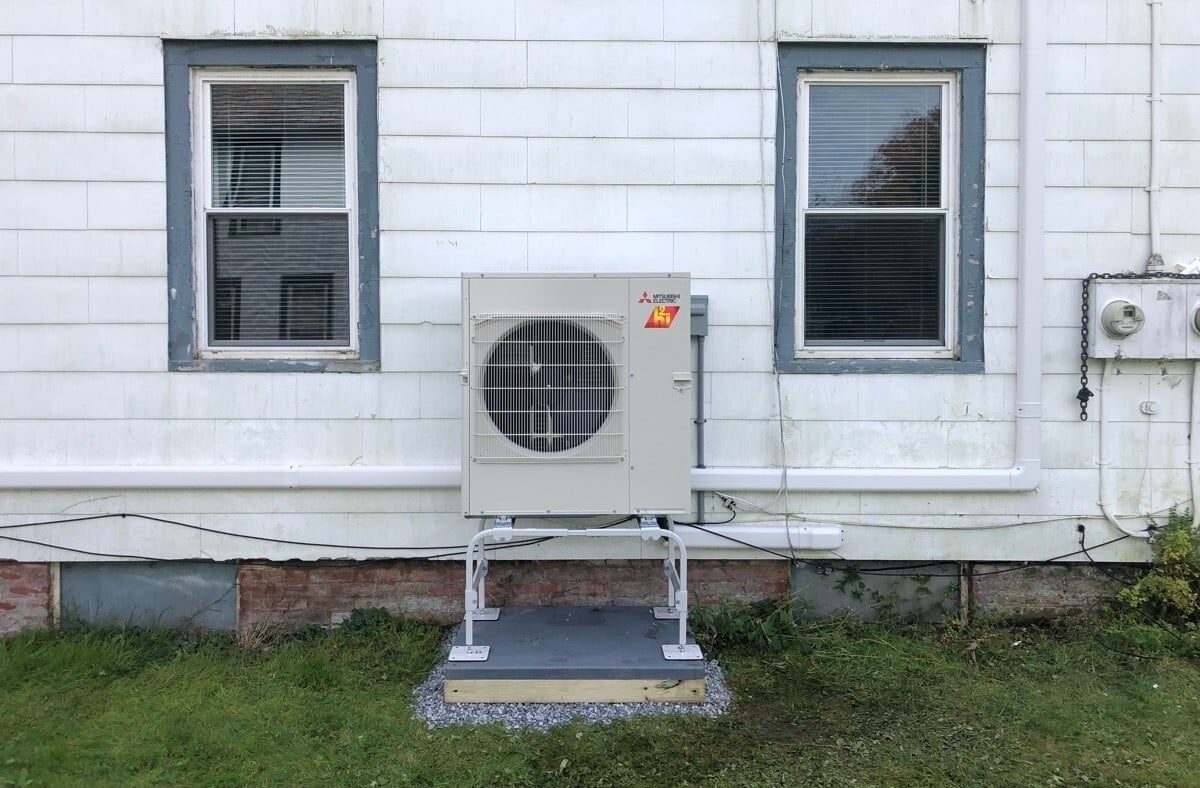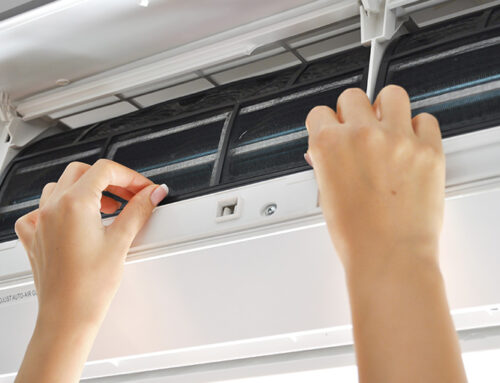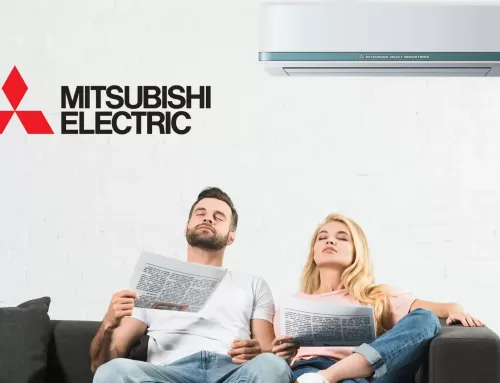Cold climate heat pumps are heating systems designed to work efficiently in cold weather conditions. They use refrigerant to transfer heat from the outside air to the interior of a building, even when the outdoor temperature is well below freezing. Some features that are common in cold climate heat pumps include:
- Reverse cycle defrost: This allows the heat pump to continue to operate even when there is frost or ice build-up on the outdoor unit.
- High-efficiency compressors: These compressors are designed to work efficiently even in very cold weather.
- Insulated refrigerant lines: These help to minimize heat loss as the refrigerant travels from the outdoor unit to the indoor unit.
- Enhanced air flow: This helps to ensure that the heat pump can circulate warm air throughout the building even in very cold weather.
These features are made to help cold climate heat pumps work well and efficiently even when it’s very cold outside. This makes them a popular choice for people who live in places where winters are harsh.
Are Heat Pumps Cheaper to Operate Than Traditional Furnaces?
Heat pumps can be cheaper to operate than traditional furnaces, especially in regions where heating demand is moderate to low. Heat pumps work by extracting heat from the outside air or ground and transferring it into the building, which requires less energy than generating heat through combustion, as is the case with furnaces. As a result, heat pumps typically have lower operating costs than furnaces, especially in regions where the outdoor temperature is above freezing and the heating demand is moderate.
However, in regions with very cold weather, heat pumps may struggle to extract enough heat from the outside air and may need to be supplemented by a secondary heating source, such as a furnace or electric resistance heating. In these cases, the operating costs of a heat pump can be higher than those of a traditional furnace.
It is also important to note that the operating costs of heat pumps can vary widely depending on the specific model and its efficiency rating, as well as the cost of electricity in your area. For this reason, it is always a good idea to consult with a professional heating and cooling contractor to determine the best heating solution for your home, based on your specific needs and budget.

The History of Cold Climate Heat Pumps
The history of cold climate heat pumps can be traced back to the early 20th century, when the first refrigeration systems were developed. These systems were initially used for cooling and refrigeration purposes, but they were later adapted for heating as well.
In the 1960s and 1970s, advances in technology led to the development of more efficient and reliable heat pumps, and these systems became increasingly popular as a source of heating and cooling in both residential and commercial buildings.
In the 1980s and 1990s, manufacturers began developing heat pumps specifically designed for use in cold climates. These systems were equipped with features such as reverse cycle defrost and high-efficiency compressors that allowed them to perform effectively even in extremely cold weather.
Today, cold climate heat pumps are a popular choice for homeowners in regions with harsh winter weather, and they continue to be improved and refined to meet the growing demand for energy-efficient and environmentally friendly heating solutions.
Heat Pumps Statistics
Here are some statistics related to heat pumps:
- Market growth: The global heat pump market is expected to grow at a compound annual growth rate (CAGR) of around 8% from 2020 to 2027.
- Energy efficiency: Heat pumps are typically more energy efficient than traditional heating systems such as furnaces, with some models achieving annual energy efficiency ratios (SEER) of up to 20.
- Adoption rate: The adoption rate of heat pumps has been increasing in recent years, with the number of installed units expected to reach over 200 million by 2026.
- Cost-effectiveness: Heat pumps can be cost-effective in the long run, with some estimates suggesting that homeowners can save up to 40% on their heating and cooling costs compared to traditional heating systems.
- Environmental impact: Heat pumps have a lower carbon footprint compared to traditional heating systems, as they do not rely on fossil fuels and emit fewer greenhouse gases.
It is important to note that these statistics may vary based on factors such as the specific type of heat pump, the location, and the cost of electricity. However, heat pumps are generally considered a cost-effective and environmentally friendly option for heating and cooling homes and buildings.
Are There Tax Credits for using a Heat Pump?
Yes, there are tax credits available for using a heat pump. In the United States, the federal government offers tax credits for homeowners who install energy-efficient systems, including heat pumps. The exact amount of the credit and the eligibility criteria can vary, but as of 2021, homeowners can receive a tax credit of up to 26% of the cost of the heat pump, including installation, up to a maximum of $500.
It is important to note that tax credits for heat pumps may have specific requirements, such as minimum efficiency ratings, and they may be subject to change. It is always a good idea to check with a tax professional or the Internal Revenue Service (IRS) for the most up-to-date information on tax credits for heat pumps.
In addition to the federal tax credit, some states and localities may also offer additional incentives for using heat pumps. For example, some states offer rebates or other financial incentives to encourage homeowners to adopt energy-efficient technologies.
To learn more about the specific tax credits and incentives available in your area, it is a good idea to consult with a tax professional or to check the Database of State Incentives for Renewables & Efficiency (DSIRE).
Rebates for Home Owners in New York for Using Heat Pumps?
Homeowners in New York state may be eligible for rebates for using heat pumps. The specific rebates available and the eligibility criteria can vary, but here are a few programs that offer rebates for heat pumps in New York:
- New York State Energy Research and Development Authority (NYSERDA): NYSERDA offers rebates to homeowners who install eligible heat pumps as part of its Home Performance with ENERGY STAR program. The rebates can cover up to 50% of the cost of the heat pump and installation, up to a maximum of $2,000.
- National Grid: National Grid, a utility company serving parts of New York state, offers rebates to customers who install eligible heat pumps as part of its Home Energy Solutions program. The rebates can cover up to $1,500 of the cost of the heat pump and installation.
- Con Edison: Con Edison, a utility company serving parts of New York City and Westchester County, offers rebates to customers who install eligible heat pumps as part of its Energy-Efficiency program. The rebates can cover up to $1,500 of the cost of the heat pump and installation.
It is important to note that these programs and rebates are subject to change and may have specific eligibility criteria, such as income requirements or the use of certain contractors. Homeowners in New York should check with their local utility companies and NYSERDA for the most up-to-date information on rebates for heat pumps.
Does Mitsubishi Contractors Offer Special Financing for Heat Pumps?
It is possible that Mitsubishi contractors may offer special financing options for heat pumps. However, the availability of financing options and the terms of those options can vary depending on the contractor and the specific heat pump being installed.
It is best to contact a local Mitsubishi contractor to discuss the financing options available for heat pumps. The contractor can provide information on the specific financing options they offer, including any special promotions or financing programs that may be available, as well as the terms and conditions of those options.
In addition to financing options offered by Mitsubishi contractors, there may also be financing options available through banks, credit unions, and other financial institutions. Homeowners should compare the terms and conditions of these options to determine which financing option is best for their needs.






Leave A Comment